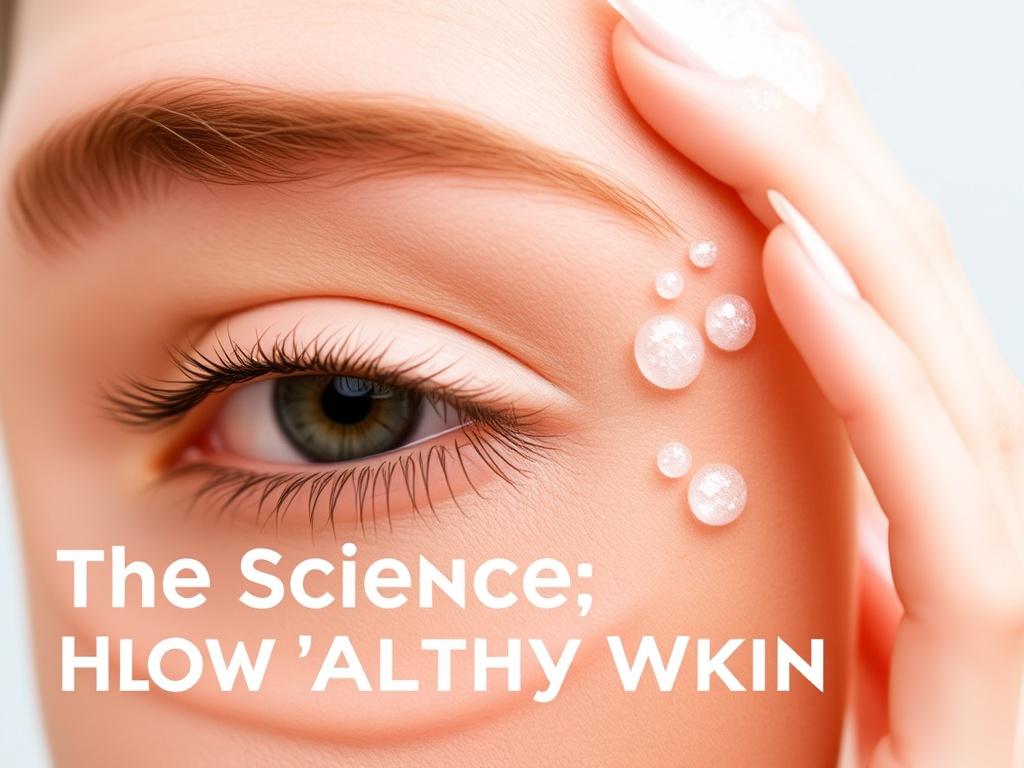Содержание статьи
- 1 What Is Skin? Unveiling the Largest Organ of the Body
- 2 The Functions of Your Skin: More Than Meets the Eye
- 3 The Role of Sebum: Nature’s Skin Moisturizer
- 4 How Your Skin Fights Environmental Stressors
- 5 Nutrition and Hydration: Fuel for Healthy Skin
- 6 Skincare Habits That Support Skin Science
- 7 How Aging Affects Your Skin’s Science
Our skin is truly one of the most fascinating and complex organs in the human body. It’s not just a simple covering or protective barrier — it’s a living, breathing system that plays a vital role in maintaining our overall health and well-being. Understanding the science of healthy skin and how your skin works is essential if you want to keep it glowing, youthful, and resilient through all the challenges life throws at it. From daily sun exposure to aging and pollution, skin health depends on a delicate balance of biological processes that operate beneath the surface. So, let’s dive deep into the incredible science of your skin and discover how it functions, how to care for it, and why it matters.
What Is Skin? Unveiling the Largest Organ of the Body
When we talk about skin, we’re discussing the body’s largest organ, covering an average area of about 20 square feet in adults. But skin isn’t just about size—it’s a highly specialized organ with multiple layers, each serving a unique purpose.
The skin has three primary layers:
| Layer | Description | Function |
|---|---|---|
| Epidermis | Outermost layer | Creates a waterproof barrier and protects against environmental damage |
| Dermis | Middle layer beneath the epidermis | Contains hair follicles, sweat glands, blood vessels, and collagen for support |
| Hypodermis (subcutaneous layer) | Deepest layer | Insulates the body and cushions muscles and bones |
Understanding how these layers interact is crucial to grasping the science of healthy skin. The epidermis renews itself constantly, while the dermis provides strength and elasticity through collagen and elastin fibers. The hypodermis stores fat and helps regulate temperature. This complex structure means your skin does more for you than just looking good.
The Functions of Your Skin: More Than Meets the Eye

You might think your skin only serves as protection against dirt and germs, but it’s far more than that. Knowing how your skin works means appreciating its multiple functions:
- Protection: The skin acts as a physical shield against harmful ultraviolet (UV) rays, pathogens, and environmental pollutants.
- Sensation: Nerve endings in your skin detect temperature, pain, pressure, and touch, helping you react to the world around you.
- Temperature Regulation: Through sweating and blood vessel dilation, your skin helps maintain your body’s internal temperature.
- Vitamin D Production: Exposure to sunlight stimulates the skin to produce vitamin D, essential for bone health and immune function.
- Immune Defense: Your skin contains specialized cells that detect foreign invaders and activate immune responses.
All of these functions work together seamlessly to keep your body safe and balanced. But the science of healthy skin shows us that damage or imbalance in any of these roles can lead to problems like dryness, irritation, premature aging, or skin disease.
The Epidermis: Your Skin’s Frontline Defender
The epidermis is where your skin’s protective magic begins. This thin but powerful layer is mainly made up of keratinocytes, which produce keratin—a tough protein that waterproofs and shields the skin. As these keratinocytes migrate upwards, they die off and form a protective outer shell called the stratum corneum. Think of it as a natural armor.
Within the epidermis are melanocytes, the pigment-producing cells that determine your skin color and help protect you from UV damage by absorbing harmful rays. Additionally, Langerhans cells patrol this layer as immune sentinels, ready to alert the body to threats.
How Skin Cells Renew and Heal
One amazing fact about the epidermis is its ability to constantly renew itself every 28 to 30 days. New skin cells form at the basal layer, slowly migrating to the surface where they replace older, dead cells. This cycle is vital for healing wounds, shedding pollutants, and maintaining a smooth, healthy surface.
However, factors like aging, pollution, smoking, and poor nutrition can disrupt this renewal process, leading to dull, flaky, or uneven skin. The science of healthy skin emphasizes the importance of supporting this natural cycle through proper skincare, hydration, and a balanced diet.
The Dermis: Strength and Vitality Beneath the Surface
Beneath the epidermis lies the dermis, a thick, fibrous layer that provides structure and nourishment. This is where the magic of collagen and elastin happens—two proteins that give your skin its strength and elasticity. Collagen acts as a scaffold, holding skin cells together, while elastin allows the skin to stretch and bounce back.
The dermis also contains important components like:
- Blood vessels: Deliver oxygen and nutrients essential for skin vitality.
- Nerve endings: Provide sensation to the skin’s surface.
- Hair follicles: Anchor the hair and support its growth.
- Sweat glands: Help regulate temperature and excrete waste.
- Oil (sebaceous) glands: Produce sebum that moisturizes and protects skin.
Damage to the dermis, whether from injury, prolonged sun exposure, or aging, leads to wrinkles, sagging, and loss of firmness. This fact underlines why protecting your skin from sun damage and supporting collagen production is essential for lifelong skin health.
The Role of Sebum: Nature’s Skin Moisturizer
One aspect of skin science many people overlook is sebum—a natural oil produced by sebaceous glands embedded in the dermis. Sebum has a crucial role in maintaining healthy skin by:
- Keeping the skin waterproof and preventing excess water loss.
- Protecting against microbial infections by creating a mildly acidic skin surface.
- Providing nutrients and lubrication to keep skin supple and smooth.
However, sebum production can sometimes go awry, causing oily skin or clogged pores. Understanding how your skin works and balancing sebum with good cleansing habits can help prevent acne and other issues. Remember, overwashing or harsh cleansers can strip your skin of sebum, causing dryness and irritation.
How Your Skin Fights Environmental Stressors

Every day, your skin battles a variety of environmental challenges — UV rays from the sun, pollution, harsh weather, and even stress. The science of healthy skin involves grasping how your skin defends itself and what you can do to support these defenses.
The Impact of UV Radiation on Skin Health
Ultraviolet radiation is the most significant environmental factor affecting skin health. UV rays penetrate your skin, causing DNA damage and oxidative stress, which accelerates aging and increases the risk of skin cancer.
In response, your skin increases melanin production to protect deeper layers, but prolonged exposure overwhelms this defense system. That’s why consistent use of sunscreen, wearing protective clothing, and avoiding peak sun hours are crucial habits for healthy skin.
Pollution and Skin Aging
Pollution is another silent skin aggressor. Tiny particles from vehicle exhaust, industrial waste, and cigarette smoke penetrate the skin, triggering inflammation and damaging collagen. This leads to premature wrinkles, pigmentation, and a dull complexion.
To combat pollution damage:
- Cleanse your skin thoroughly to remove particles at the end of the day.
- Use antioxidants such as Vitamin C and E in your skincare routine to neutralize free radicals.
- Maintain a barrier with moisturizers to prevent pollutant penetration.
Nutrition and Hydration: Fuel for Healthy Skin
You’ve probably heard the phrase “beauty comes from within,” and when it comes to skin, this couldn’t be truer. The science of healthy skin explains that what you eat and how well you hydrate directly affects your skin’s appearance and function.
A balanced diet rich in vitamins A, C, D, and E, as well as minerals like zinc and selenium, provides the building blocks for new skin cells and supports antioxidant defenses. Omega-3 fatty acids, found in fish and flaxseed, help reduce inflammation and maintain the skin’s lipid barrier.
Key Nutrients for Glowing Skin
| Nutrient | Role in Skin Health | Food Sources |
|---|---|---|
| Vitamin A | Supports skin cell growth and repair | Carrots, sweet potatoes, leafy greens |
| Vitamin C | Boosts collagen synthesis and protects against oxidative damage | Citrus fruits, bell peppers, strawberries |
| Vitamin E | Protects skin from free radical damage | Nuts, seeds, spinach |
| Zinc | Promotes wound healing and immune function | Meat, shellfish, legumes |
| Omega-3 Fatty Acids | Reduces skin inflammation and supports hydration | Salmon, walnuts, flaxseeds |
Hydration is equally important. Drinking sufficient water helps maintain skin’s plumpness and elasticity by keeping cells fully hydrated and enabling toxin elimination. Dry skin often signals inadequate hydration, either from low water intake or excessive loss through environmental exposure.
Skincare Habits That Support Skin Science
Knowing how your skin works opens the door to smarter skincare habits that preserve its health. While there’s no one-size-fits-all solution, some fundamental practices can benefit everyone:
- Gentle Cleansing: Use mild products that don’t strip away natural oils.
- Moisturizing: Apply moisturizers suited to your skin type to reinforce the barrier.
- Sun Protection: Use broad-spectrum sunscreen daily, even on cloudy days.
- Avoid Harsh Exfoliation: Over-exfoliating can damage the skin’s surface and cause sensitivity.
- Healthy Lifestyle: Get enough sleep, manage stress, and avoid smoking.
Myths and Facts About Skin Care
To help clear confusion, here are some common myths related to skin health:
| Myth | Fact |
|---|---|
| Oily skin doesn’t need moisturizer | Even oily skin needs hydration; lightweight, non-comedogenic moisturizers work best. |
| Natural ingredients are always safe and better | Natural ingredients can irritate or cause allergies; efficacy depends on formulation. |
| Sunscreen isn’t necessary on cloudy days | Up to 80% of UV rays penetrate clouds, so daily sunscreen is important. |
| Eating chocolate causes acne | Current research shows no direct link; acne is complex and influenced by hormones and genetics. |
How Aging Affects Your Skin’s Science

As time passes, your skin undergoes numerous changes driven by both internal aging processes and external exposures. The rate and severity depend on genetics, lifestyle, and environment.
With aging, collagen production slows, leading to reduced elasticity and firmness. The epidermis thins, and the ability to retain moisture declines, resulting in dryness and fine lines. Blood vessel efficiency diminishes, affecting skin tone and repair capabilities.
Preventing premature aging involves protecting your skin from UV damage, maintaining hydration, and supporting collagen synthesis with antioxidants and sometimes dermatological treatments.
Innovations in Skin Science and Care
Recent advances in skin science have led to innovative treatments like:
- Retinoids: Vitamin A derivatives that promote cell turnover and collagen production.
- Peptides: Small proteins that signal skin to produce collagen and elastin.
- Antioxidant serums: Concentrated formulations that combat oxidative stress.
- Laser therapy and microneedling: Procedures that stimulate skin renewal and collagen growth.
These tools allow us to intervene in the complex biology of skin, helping to restore youthful texture and function. However, integrating innovation with daily healthy habits is the key to long-term skin vitality.
Conclusion
The science of healthy skin reveals just how intricate and essential this living organ is to our overall wellness. From its layered structure and protective roles to its incredible ability to renew and defend itself, understanding how your skin works empowers you to take better care of it. Skin health is influenced by a combination of genetic factors, environmental exposures, lifestyle choices, and nutrition. Embracing gentle skincare routines, protecting against sun and pollution, supporting collagen and hydration, and debunking myths all contribute to maintaining your skin’s natural balance and radiant appearance. Ultimately, your skin is not simply a cosmetic surface — it is a dynamic, vital interface with the world, deserving of attention, care, and respect every day.


